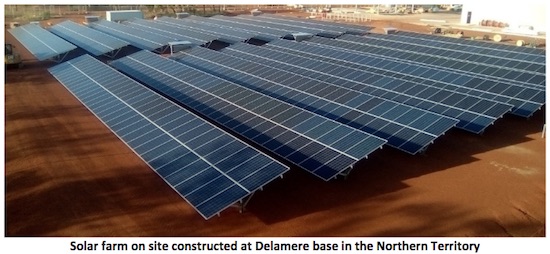



The microgrid is being built at the Delamere Air Weapons Range south of Darwin by Energy Made Clean, a wholly owned subsidiary of ASX-listed renewables developer Carnegie Clean Energy.
EMC won the Department of Defence contract for the job in July last year, to design a hybrid energy system that would supply high penetration solar power to approximately 200kVA peak load and cut the facility’s fuel usage by more than 60 per cent.
In a project update late last week, Carnegie said the solar farm construction on site was now complete (pictured above), as was the manufacture and factory testing of the battery energy storage system (BESS).
“The project has now entered its final phase which involves installing the BESS containers, primary and standby diesel generators and solar inverters at site ahead of site acceptance testing and commissioning,” the company said.


As we reported here, the Delamere project marked the second Department of Defence contract for a renewable energy hybrid microgrid system, which was also delivered by EMC at Bathurst Island in 2015.
DoD has since launched two further tenders: one for a 1.2MW array at a communications base in WA; and another, in November, for a combined total of 12.5MW of solar for its Robertson Barracks, also in the Northern Territory, and its RAAF base in Darwin.
Before this, in 2015, Defence Housing Australia announced the creation of a “solar suburb” near Darwin, with each home to feature 4.5kW of rooftop solar and charging points for electric vehicles.
At the time, DHA said the development at Breezes Muirhead would create a 337kW solar suburb, producing 600,000kWh of solar electricity a year, and save Defence members more than $4.125 million in electricity costs over the development’s lifetime.
Carnegie, which acquired EMC in October 2016, says the Delamere microgrid is exactly the sort of complex and high value project EMC is “uniquely positioned” to deliver.
“Increasingly, off grid and fringe of grid customers are seeking a combination of cost effective, reliable and clean energy solutions that can now be achieved by these state of the art microgrids,” said Carnegie managing director Michael Ottaviano in a statement.
“Projects of this size, with a contract value of $3-4 million, have put EMC on track to record revenues in the current half of the 2018 financial year,” he said.
The Delamere project is on track for completion in quarter 3, 2018, Carnegie said.
Sophie is editor of One Step Off The Grid and deputy editor of its sister site, Renew Economy. Sophie has been writing about clean energy for more than a decade.
This post was published on May 16, 2018 10:17 am
Modern heat-pump technology means air conditioning is becoming the go-to solution in hot weather. But…
Community independent Nicolette Boele explains how better climate and energy policy could help tackle Australia’s…
The pursuit of water and energy self-sufficiency on a small block in a densely-populated area…
State trial of one-stop-shops for households wanting to go all electric gets expanded to two…
A home battery that made its debut in Australia less than two years ago has…
ANU Senior researcher Dr Cheng Cheng reveals the electorates that could benefit most from renewables,…
View Comments
So droll. The government is rabidly opposed to renewables, but the biggest spending Gov't department is doing stuff like this, establishing beyond all doubt that the Gov't is barking mad. Rabid.
And not only that, the person who designed or installed the array layout didn't allow enough spacing between the strings. The shading is going to reduce output markedly. Another meter spacing would have killed it!
Oh yes! From the shadow pattern it looks like this shot is taken mid morning. Middle of the day with sun higher no problem, but only around 3 hours of good exposure. What were they thinking!
And the panels look very flat, too. Just Googled Darwin latitude, 12.46°S, so pitch should be 27.5° . Those are nothing like that high. What do you think?
They weren't thinking enough is the only answer and I forgot to mention shading from the trees too.
I haven't looked at a sun path map for that latitude 12.6 is probably correct, you don't have to add 15 degrees to it, as that's best for winter performance, but up that way the sun tracks differently than down our way over the seasons.
Seem to remember reading about that in one of my permaculture books.
Midsummer, sun rises and sets well south of east and west. Most of the time almost directly overhead.